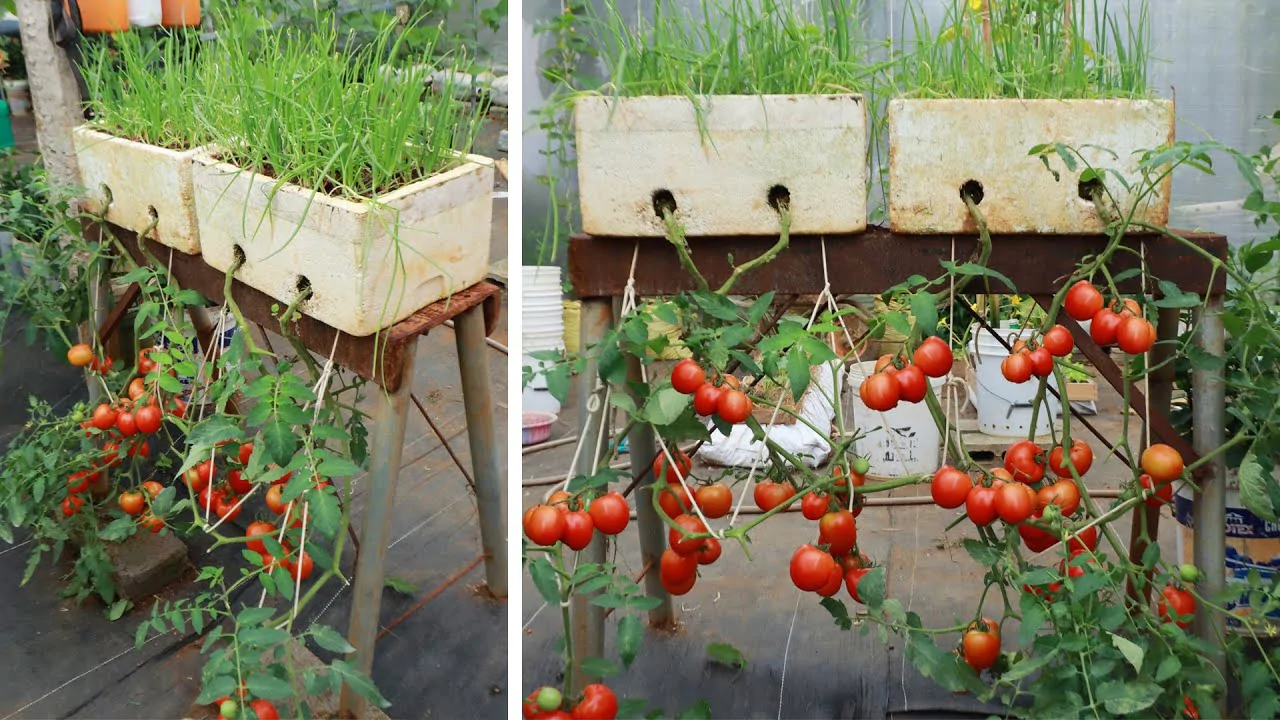
While doing your gardening research, you must have come across planters made to hold a tomato plant upside down. This unorthodox growing method can be entertaining for those looking to spice things up in their garden. Furthermore, it can assist those with limited gardening spaces to find a little extra room.
Limited gardening space poses challenges for many people trying to fit all the desired plants into the available space. It is worth noting that upside down tomato plants not only save space in the garden, but they are also one of the few plants that can thrive when grown upside down.
You will find that there are a few commercially manufactured planters designed specifically for this purpose as well as some do-it-yourself options.
Besides the space advantage, there are several other benefits to this technique. Staking or caging upside down tomato plants is not required, making plant maintenance easier.
Lack of possible weed growth is another benefit that these planters offer. The upside down growing position improves air circulation, reducing vulnerability to many diseases.
Choosing an Upside Down Tomato Planter
If you are trying to find the simplest method to grow tomatoes upside down, a commercially made planter would work best. They are ready to use, unlike the do-it-yourself alternatives which are homemade.
You might find different types in the market, but by far the most popular one is Topsy Turvy.
This planter is the one responsible for the upside down tomato growing craze. In fact this planter received an Amazing Inventions award from Time Magazine in 2005. Moreover, it is very simple; just fill the planter with potting soil, put in a tomato plant and hang it.
Each planter can hold up to 2 tomato plants which means that with one or two different planters, it is possible to achieve a substantial harvest. It is also easy to water and maintain your planters.
Some individuals decide to construct upside down tomato planters by themselves. The process is relatively straightforward, and it can be budget-friendly. What you will need is a 5-gallon bucket with a handle.
Like with any other DIY project, start by cutting a hole in the bottom of the bucket for the tomato plant. A 2-3 inch hole works well. Go ahead and plant your tomato plant, then secure it using a coffee filter or a piece of a peat pot as shown in this video here.
Using the bucket handle, the planter can be hung once ready. When filled with wet soil, these buckets get really heavy, so if you plan to use one as a planter, exercise caution. Make sure to use a sturdy plant hook and heavy-duty fasteners however, secure it to a post or wall.
Soil Considerations for Growing Tomatoes Upside Down
If you plan to make your own upside down tomato hanger or buy a commercially made one, remember to use high quality soil for better results. Potting soil is a good choice.
To best care for your tomato plants, it is best to maintain even moisture levels. This can be achieved by adding a layer of mulch or peat moss to the top layer of soil. To maintain soil nutrients, tomatoes should be fertilized regularly to replenish the nutrients they remove.
As nutrients must be contended with over the season, it is recommended that when planting new tomato plants, fresh soil is added each growing season.
Best Upside Down Tomato Varieties
Some tomato varieties bear fruit more effectively when grown upside down. It is the patio and container varieties that are best suited because they thrive in limited soil and space.
In general patio varieties and those with small fruit are a great choice. To get you started, here are some suggestions for these tomatoes.
- Tumbling Tom – This variety of tomato is ideal for growing upside down as it is bred for hanging pots and planters. You can find the Tumbling Tom tomatoes in both red and yellow colors. It will bear fruit in approximately 70 days.
- Yellow Canary – This variety yields attractive, delicious yellow fruit within 55 days. This is a good candidate for upside down growing because it requires less light compared to other tomato varieties. The downside hanging position can limit light exposure to the plants.
Choosing a Location for Upside Down Tomato Planters
As with any gardening endeavor, the site you choose will greatly influence the outcome of your upside down planter. When selecting a spot to hang your planters, a location with 8 or more hours of direct sunlight is necessary since tomatoes need a lot of light.
From a maintenance perspective, the placement should allow easy access for watering the plants as well. Keeping the soil consistently moist is crucial. In warm weather, daily watering or even two times a day may be required.
Other Upside Down Tomato Resources
For those looking to get creative, Curbly has some fascinating instructions for upside down tomato planters.
Old Fashioned Living has yet another DIY bucket method for growing tomatoes.
The New York Times has written an article about upside down tomatoes and all their intrigue.